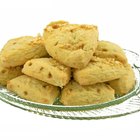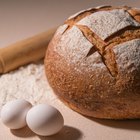
Home-baked goodies are always welcome at a family or company meal. Both the traditional crescent rolls that grace your table at holidays and the puff pastry in an elegant hors d'oeuvres or dessert are easier to make at home than some cooks imagine. Of the two, puff pastry demands far greater time and exactitude, and each has very specific uses in cuisine. Some intermediate versions attempt to combine both efficiency and elegance.
Crescent Roll Pastry
Classic crescent rolls are made from a bread-like yeast-raised dough enriched with softened or melted butter. It is the addition of butter that accounts in large measure for the rolls' appealing taste. In some recipes, the dough is rolled into a flat circle, then covered with melted or softened butter before wedges are cut and rolled into crescent shapes. Other recipes specify brushing the rolls with melted butter, instead of an egg-wash, before baking. Crescent-roll dough is light and slightly sweet, suitable for making knots, fold-over and other shapes, in addition to the traditional moon shape.
Flaky Crescent Hybrids
According to a poll conducted by King Arthur Flour, respondents were evenly divided between those favoring a light, tender crescent roll and those preferring a crisp flaky version. Hybrid recipes, relying on the original yeast version but adding crispness, rely on a mixture of yeast and baking powder, combine flour with cold butter as for pie crust and may incorporate sour cream. Dough is rolled, folded and rerolled several times, in imitation of the technique that produces classic puff pastry.
Classic Puff Pastry
Unlike crescent-roll dough, puff pastry depends on combining flour and other ingredients with chilled -- rather than softened -- butter. Puff pastry, or pate feuillete, contains neither yeast nor baking powder. It is raised strictly through the interactions of flour, water and the multiple layers of butter rolled between them. Pate feuillete, sometimes called mille-feuille -- or thousand-leafed -- requires several hours to make according to the traditional method. Pounded sheets of ice-cold butter are laid on butter-laced dough, folded and rolled repeatedly. Each fold-roll cycle is called a turn, and the goal of classic puff-pastry makers is 729 turns per batch. The mechanics of puff-pastry, once practiced, are not difficult, but the traditional process is arduous.
Croissant Dough Variation
Puff pastry can be made more quickly using a croissant recipe. Croissant dough combines the leavening properties of yeast with the steaming and melting properties that give puff pastry its loft. Croissant dough is wrapped around the pounded, ice-cold butter used for puff-pastry, but the presence of yeast lets you reduce the number of fold-roll turns to three of four.
Mock Puff Pastry
Confronted with last-minute company, you need only flour, butter and sour cream to make a very flaky pastry that assembles quickly into cheese straws, a pot-pie crust or a dessert shell without leaving you and your kitchen in chaos. Some recipes include baking powder or egg, but all emphasize speed and convenience. Like traditional crescent rolls, traditional puff pastry and all the variants in between, the smell, taste and texture raise an ordinary meal to festive levels.
Related Articles

List of French Pastries

Can You Make Croissants With Baking ...

What Is the Difference Between Scones & ...

What Is Indian Flat Bread Called?

Butter to Flour Ratio for Croissants

How to Make Light Airy Italian Bread ...
How to Make Homemade Ham and Cheese Hot ...

Softened vs. Melted Butter When Baking

What is the Origin of the Croissant?

Why Use Baking Powder in Pancake Batter?
Can You Refrigerate Homemade Yeast ...

5 Examples of Yeast Breads

Lumpia vs. Egg Rolls

Whole Eggs Vs. Egg Yolks for Sweet Bread

What Is Artisan Bread?
How to Make Bread That Does Not Crumble ...

What Is the Difference Between a Bagel ...

How to Make Nigerian Bread

Shortbread Cookie Recipe

Adding Cold Water to Whipped Butter
References
- Baking Bites: Homemade Crescent Rolls
- King Arthur Flour: Flaky Buttery Crescent Rolls: The Best of Both Worlds
- Fine Cooking: A Shortcut to Flaky Puff Pastry
- King Arthur Flour: Classic Puff Pastry (Pate Feuilletee)
- Clabber Girl: Mock Puff Pastry Cheese Danish
- King Arthur: Fast and Easy Puff Pastry
- Fine Cooking: Classic Croissants
- Good Housekeeping: Palmiers
Writer Bio
Janet Beal has written for various websites, covering a variety of topics, including gardening, home, child development and cultural issues. Her work has appeared on early childhood education and consumer education websites. She has a Bachelor of Arts in English from Harvard University and a Master of Science in early childhood education from the College of New Rochelle.
Photo Credits
Stockbyte/Stockbyte/Getty Images